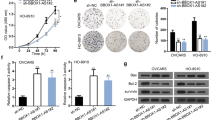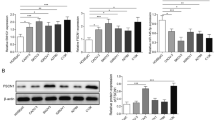Abstract
Ovarian cancer is one of the leading lethal gynecological cancers, causing serious harm to the health of female populations. Growing studies emphasize that lncRNAs serve as significant regulators in the tumorigenesis and evolution of numerous malignancies, including ovarian cancer. Recently, the oncogenic activity of lncRNA ARAP1-AS1 has been justified in a variety of cancers. However, the potential function of ARAP1-AS1 in ovarian cancer development is still unclear. Herein, we firstly revealed the expression profile of ARAP1-AS1 in ovarian cancer. Compared to normal samples and cells, upregulation of ARAP1-AS1 was observed in tissues and cells of ovarian cancer. Therewith, it was disclosed that knockdown of ARAP1-AS1 alleviated the carcinogenicity of ovarian cancer cells. Besides, our findings delineated that ARAP1-AS1 silence inhibited the expression of oncogene PLAGL2. Considering that ARAP1-AS1 was principally expressed in the the cytoplasm of ovarian cancer cells, we speculated that ARAP1-AS1 facilitated ovarian cancer progression via functioning as a ceRNA. Further investigations indicated that ARAP1-AS1 promoted PLAGL2 expression by competitively binding with miR-4735-3p. Of note, ARAP1-AS1 contributed to the malignant phenotypes of ovarian cancer cells through modulation of miR-4735-3p/PLAGL2 axis, revealing ARAP1-AS1 as a promising therapeutic target for ovarian cancer patients.





Similar content being viewed by others
Change history
21 December 2021
A Correction to this paper has been published: https://doi.org/10.1007/s10616-021-00512-0
References
Ding Z et al (2019) LncRNA FBXL19-AS1 promotes breast cancer cells proliferation and invasion via acting as a molecular sponge to miR. Biosci Rep 39(4):12
Fan Y et al (2020) LncRNA MIF-AS1 aggravates the progression of ovarian cancer by sponging miRNA-31-5p. Eur Rev Med Pharmacol Sci 24(5):2248–2255
Fritah S, Niclou SP, Azuaje F (2014) Databases for lncRNAs: a comparative evaluation of emerging tools. RNA 20(11):1655–1665
Guo J et al (2016) Overexpression of pleomorphic adenoma gene-like 2 is a novel poor prognostic marker of prostate cancer. PLoS ONE 11(8):e0158667
Hensen K et al (2002) The tumorigenic diversity of the three PLAG family members is associated with different DNA binding capacities. Cancer Res 62(5):1510–1517
Jayson GC et al (2014) Ovarian cancer. Lancet 384(9951):1376–1388
Jiang YH et al (2020) Increased long non-coding RNA ARAP1-AS1 expression and its prognostic significance in human gastric cancer: a preliminary study. Eur Rev Med Pharmacol Sci 24(4):1815–1820
Kim JY, Cho CH, Song HS (2017) Targeted therapy of ovarian cancer including immune check point inhibitor. Korean J Intern Med 32(5):798–804
Liu G et al (2017) SP1-induced up-regulation of lncRNA SNHG14 as a ceRNA promotes migration and invasion of clear cell renal cell carcinoma by regulating N-WASP. Am J Cancer Res 7(12):2515–2525
Lu C et al (2020) Long non-coding RNA ARAP1-AS1 accelerates cell proliferation and migration in breast cancer through miR-2110/HDAC2/PLIN1 axis. Biosci Rep. https://doi.org/10.1042/BSR20191764
Majem B et al (2019) MicroRNA-654-5p suppresses ovarian cancer development impacting on MYC WNT and AKT pathways. Oncogene 38(32):6035–6050
Moufarrij S et al (2019) Epigenetic therapy for ovarian cancer: promise and progress. Clin Epigenetics 11(1):7
Murali R, Grisham RN, Soslow RA (2018) The roles of pathology in targeted therapy of women with gynecologic cancers. Gynecol Oncol 148(1):213–221
Pradeep S et al (2014) Hematogenous metastasis of ovarian cancer: rethinking mode of spread. Cancer Cell 26(1):77–91
Rustin G et al (2011) Early versus delayed treatment of relapsed ovarian cancer. Lancet 377(9763):380–381
Siegel RL, Miller KD, Jemal A (2018) Cancer statistics, 2018. CA A Cancer J Clinician 68(1):7–30
Siegel RL, Miller KD, Jemal A (2016) Cancer statistics. CA A Cancer J Clinician 66(1):7–30
Gumusoglu E et al (2021) The importance of dysregulated miRNAs on ovarian cysts and epithelial ovarian cancer. Eur J Gynaecol Oncol 42(1):66–72
Teng J et al (2019) Long non-coding RNA ARAP1-AS1 promotes the progression of bladder cancer by regulating miR-4735-3p/NOTCH2 axis. Cancer Biol Ther 20(4):552–561
Wang Q, López-Ozuna VM (2020) Biguanides in combination with olaparib limits tumorigenesis of drug-resistant ovarian cancer cells through inhibition of Snail. Cancer Med 9(4):1307–1320
Wang J et al (2020) Long non-coding RNA RHPN1-AS1 promotes tumorigenesis and metastasis of ovarian cancer by acting as a ceRNA against miR-596 and upregulating LETM1. Aging (Albany NY) 12(5):4558–4572
Wu K et al (2020) Long non-coding RNA HAL suppresses the migration and invasion of serous ovarian cancer by inhibiting EMT signaling pathway. Biosci Rep. https://doi.org/10.1042/BSR20194496
Wu L et al (2020) PLAGL2 promotes epithelial-mesenchymal transition and mediates colorectal cancer metastasis via β-catenin-dependent regulation of ZEB1. Br J Cancer 122(4):578–589
Wu Z et al (2016) MiR-218-5p inhibits the stem cell properties and invasive ability of the A2B5+CD133- subgroup of human glioma stem cells. Oncol Rep 35(2):869–877
Xu B et al (2018) MiR-449a suppresses cell migration and invasion by targeting PLAGL2 in breast cancer. Pathol Res Pract 214(5):790–795
Xue F et al (2020) Non-coding RNA LOXL1-AS1 exhibits oncogenic activity in ovarian cancer via regulation of miR-18b-5p/VMA21 axis. Biomed Pharmacother 125:109568
Xu QF, Tang YX, Wang X (2018) LncRNA EBIC promoted proliferation, metastasis and cisplatin resistance of ovarian cancer cells and predicted poor survival in ovarian cancer patients. Eur Rev Med Pharmacol Sci 22(14):4440–4447
Yao N et al (2018) LncRNA GIHCG promotes development of ovarian cancer by regulating microRNA-429. Eur Rev Med Pharmacol Sci 22(23):8127–8134
Yang G, Lu X, Yuan L (2014) LncRNA: a link between RNA and cancer. Biochim Biophys Acta 1839(11):1097–1109
Yang J et al (2017) LncRNA PVT1 predicts prognosis and regulates tumor growth in prostate cancer. Biosci Biotechnol Biochem 81(12):2301–2306
Ye Y et al (2019) YY1-Induced upregulation of long noncoding RNA ARAP1-AS1 promotes cell migration and invasion in colorectal cancer through the Wnt/β-catenin signaling pathway. Cancer Biother Radiopharm 34(8):519–528
Zhang Y, Wu D, Wang D (2020) Long non-coding RNA ARAP1-AS1 promotes tumorigenesis and metastasis through facilitating proto-oncogene c-Myc translation via dissociating PSF/PTB dimer in cervical cancer. Cancer Med 9(5):1855–1866
Zhang X, Ho TT (2019) Computational analysis of lncRNA function in cancer. Methods Mol Biol 1878:139–155
Zhan Y et al (2018) Long non-coding RNA DANCR promotes malignant phenotypes of bladder cancer cells by modulating the miR-149/MSI2 axis as a ceRNA. J Exp Clin Cancer Res 37(1):273
Zhao X et al (2018) Linc00511 acts as a competing endogenous RNA to regulate VEGFA expression through sponging hsa-miR-29b-3p in pancreatic ductal adenocarcinoma. J Cell Mol Med 22(1):655–667
Zhao H et al (2018) Lowly-expressed lncRNA GAS5 facilitates progression of ovarian cancer through targeting miR-196-5p and thereby regulating HOXA5. Gynecol Oncol 151(2):345–355
Acknowledgements
We deeply appreciate the supports by all participants.
Funding
This work was supported by Qiqihar science and technology plan innovation incentive project (No: CSFGG-2020002).
Author information
Authors and Affiliations
Corresponding author
Ethics declarations
Conflict of interest
The authors state that there is no conflict of interest.
Additional information
Publisher's Note
Springer Nature remains neutral with regard to jurisdictional claims in published maps and institutional affiliations.
The original online version of this article was revised: the funding number CSFGG202002 is updated as CSFGG2020002.
Rights and permissions
About this article
Cite this article
Li, C., Dong, B., Xu, X. et al. LncRNA ARAP1-AS1 aggravates the malignant phenotypes of ovarian cancer cells through sponging miR-4735-3p to enhance PLAGL2 expression. Cytotechnology 73, 363–372 (2021). https://doi.org/10.1007/s10616-021-00463-6
Received:
Accepted:
Published:
Issue Date:
DOI: https://doi.org/10.1007/s10616-021-00463-6




